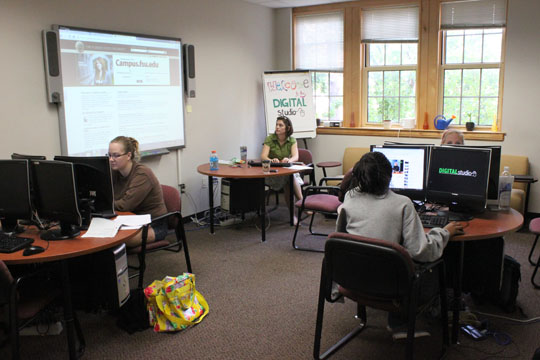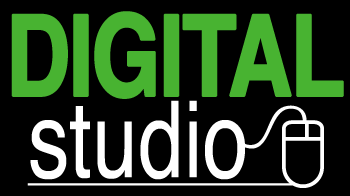
Welcome
Using Florida State’s Digital Studios as a case study, this chapter attempts to answer the following:
- What happens in a Digital Studio? What are the goals for and services offered by a Digital Studio?
- How is a vision for the Digital Studio shaped by institutional, disciplinary, and pedagogical needs?
- How does that vision evolve when those needs change?
- How are physical Digital Studio spaces designed: what is in them and how are they defined?
- How does a revolving cast of enthusiastic and sometimes inexperienced tutors receive training and support, which is a constant and recurring need?
- What issues of sustainability does a Digital Studio face?
- What can a Digital Studio teach us about composing in a digital age?
While we are under the working assumption that our engagement with these questions will be valuable to others, we acknowledge that the FSU Digital Studio (DS), which opened in the fall of 2008 and expanded to a second location in the fall of 2011, has an institutional context that makes it unique among other “next-gen learning” spaces. For instance, the two Digital Studio locations are under the auspices of the English Department and are affiliated with the Department’s Reading Writing Center (RWC). Also, both the DS and the RWC share a faculty director and are staffed by a combination of English Department graduate teaching assistants (TAs) and undergraduate tutors. Additionally, as of summer 2012, all incoming English Department TAs take a course to prepare them to work in both the RWC and, if they choose, the DS. These contexts have shaped the ongoing mission of the DS, and they have routinely prompted questions of sustainability for DS administrators.
Through it all, the basic mission of the FSU Digital Studio has been to provide students and faculty with a space where they can work on and receive assistance with digital projects. These two prongs of the DS mission—providing space and providing assistance—have worked together as poles of a kind of continuum for administrative approaches.
On the one end, where the DS is seen as providing assistance, there is the sense that the DS is a kind of “multiliteracy center,” as predicted by John Trimbur (2000)--and picked up on by the contributors to Multiliteracy Centers: Writing Center Work, New Media, and Multimodal Rhetoric, edited by David M. Sheridan and James A. Inman (2010)--where students work one-on-one with tutors for on a range of multimodal and multimedia projects. Under this guise, the DS is a natural extension of the writing center, following in with Trimbur’s prediction that “writing center work will, if anything, become more rhetorical in paying attention to the practices and effects of design in written and visual communication— more product oriented and perhaps less like the composing conferences of the process movement” (32). Students schedule half-hour appointments, they sit down next to a tutor in front of a screen, and the pair talk about technical and rhetorical strategies.
On the other end, the DS is seen more as a collaborative, open space for production, with an emphasis on the “Studio” aspect of the Digital Studio. Instead of merely connecting students with tutors for help with software and design issues, the DS in this vision is a site for working—a place for projects, research, assignments, and building. This vision falls more in line with that of the Class of 1941 Studio for Student Communication at Clemson, which Kathleen Yancey, whose experiences developing that space influenced her vision for the FSU DS, helped develop and also described with Morgan Gresham (2000) in WPA. Students walk in without an appointment, they use the technology as they please, and they occasionally speak up to ask the tutor questions from across the room.
Where the work in the DS falls on this continuum is primarily a function of how the DS fits in with local institutional and departmental ‘ecologies’ (Fleckenstein, Spinuzzi, Rickly, & Papper, 2008; Selfe, DeVoss, & McKee, 2009). As different departmental needs are articulated, the operations of the DS shift to respond to those needs, and the space is redefined accordingly. Those ecologies also have clear bearing on the sustainability of the DS. Funding, staffing, and equipment are essential components of the Digital Studio, and they are provided by the department and the institution. As we describe in this chapter, the most prominent issues that the DS has faced, in terms of sustainability, are (1) these shifting departmental ecological articulations and (2) the continuous need for training a revolving cast of Studio staff.
As we describe the components of this chapter, these figures will provide additional context for the DS along with the RWC. The total number of tutors for both the RWC and DS is around 30-35 graduate TAs and between 40 and 60 undergraduate tutors; the DS is staffed by about ten of the total graduate student tutors. The RWC typically hosts between 4,500 and 5,000 appointments a semester. In the fall of 2009, after being open for a year, the DS recorded 34 student appointments during the second half of the semester (the middle of that semester marked the beginning of our keeping session logs). By the fall of 2012, with a second DS location having opened a year earlier, the two spaces facilitated 532 total student appointments, which in comparison with the opening semester represents a staggering growth rate in recorded appointments. While the RWC is the older, more established, and busier tutoring center, the DS’s growth rate far surpasses that of the RWC.
Although we continue to manage and respond to this growth and its implications for sustainability, we want here to share our experiences with the field thus far. As such, this web-text invites readers to follow a roughly chronological narrative-path, from the initial "Vision" for the Digital Studio to our recent "Reflection" on the Digital Studio’s history and potential future(s). Of course, readers may also create their own adventure by visiting pages in an order that seems most relevant to them. The pages “Vision,” “Training,” and “Reflection” each include a video of interviews conducted with key Digital Studio players. The text that accompanies each video is not a rehashing of what is in the video but is rather an elaboration of the themes that emerge in each.
In “Vision,” we discuss the genesis of the Digital Studio, detailing the impetus for its creation, the scholarship and past experiences informing and influencing its conception, the perceived needs it was responding to, the way those needs were shaped by its local context and impacted its attempts toward sustainability, and the way these experiences can help others in the field working to envision a similar tutoring space.
The “Training” page inquires into how tutor-training practices change in a space like the Digital Studio. More specifically, we share what our training program looked like and how it evolved, what constraints we faced in designing a sustainable training program, how technological and tutoring expertise and lack thereof affected our training, what is important to consider when designing a training program, and what we can learn from our new and inexperienced tutors.
“Reflection” is a space wherein we take a Janus-like approach and reflect on our history but in a way that also makes us contemplate the future of not only the Digital Studios at Florida State but also the future of Digital Studios and next-gen multiliteracy centers in general.
The “Williams” and “Johnston” pages invite readers to take a storybook tour through each Digital Studio location, with attention given to hardware, software, and furnishings. At the bottom of the screen throughout the site, a movable sliding timeline provides chronological context for each section and indeed for the whole site.
It is our hope that, in telling our story, readers who are considering creating their own next-gen multiliteracy space will note the similarities and differences between our institution and their own. By the same token, we feel that many of the opportunities we have enjoyed and the challenges we have faced transcend institutional boundaries and have analogues among a variety of ecologies. For those who are curious about what possibilities a Digital Studio can afford students and tutors, we hope that this site opens up the space for a vision of your own. And for those who already have Digital Studios or other next gen multiliteracy spaces, we look forward to hearing and learning from you.







